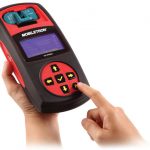Mobiletron UK replaces problem components in six easy steps.
With the introduction of new EU regulations, TPMS is a hot topic! Millions of cars in the UK are fitted with TPMS, which monitors the vehicle’s tyre pressure and will alert the driver to over- or under-inflation. In the UK, a faulty TPMS is now an automatic MOT fail on cars registered after 1 January 2012 – something which continues to catch motorists and independent workshops out.
One of the major reasons that we see independent garages failing to take advantage of TPMS servicing opportunities is due to a general lack of confidence when it comes to fitting or maintaining TPMS sensors.
The truth is, though, that with the right tools and replacement parts technicians need very little specialist training to learn how to fit TPMS sensors. Mobiletron’s range of Direct Fit and Universal MORE sensors can be used as a direct replacement for an OE sensor and they follow the same fitting process (as shown below).
All the technician needs is an 11mm socket, ratchet wrench, TPMS scan tool and the appropriate valve tool.
Step 1: Release air from the tyre by removing the valve. Place the wheel on the tyre changing machine and break both beads. Ensure the sensor is on the opposite side of the breaking bead.

Step 2: Place the wheel on the turntable and demount the tyre. The sensor can then be removed.

Step 3: Remove the existing sensor and clear the valve stem hole of any dirt or corrosion. Remove the washer, nut and valve from the new valve stem. Install the new sensor through the rim hole. Insert the stem then place the washer, followed by the nut, back on the valve. Tighten the nut to 4Nm.

Step 4: Locate the sensor body on to the other end of the valve stem. Hand tighten to secure and then tighten the connecting screw to 2.2Nm.

Step 5: Reinstall the tyre, making sure no contact is made with the new sensor to prevent damage. The tyre, complete with TPMS sensor, is now ready for inflation to the correct PSI level.

Step 6: Finally, follow the manufacturer’s standard re-learn procedure (check vehicle handbook).











